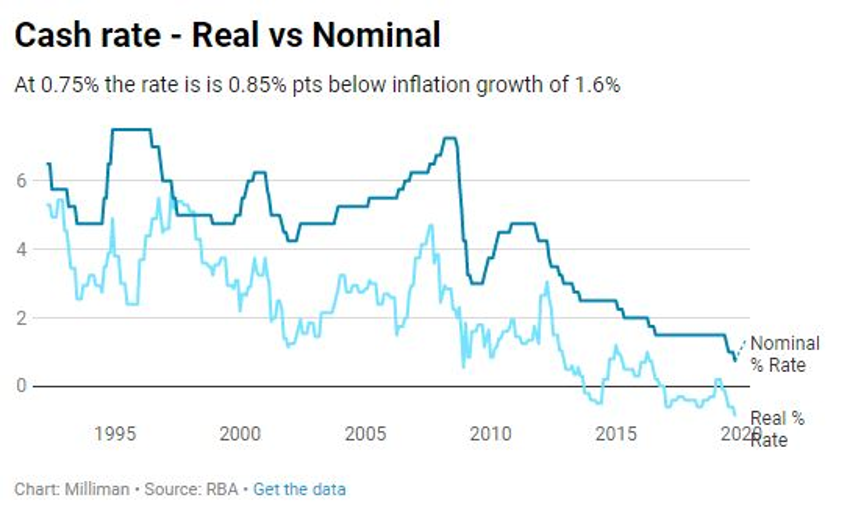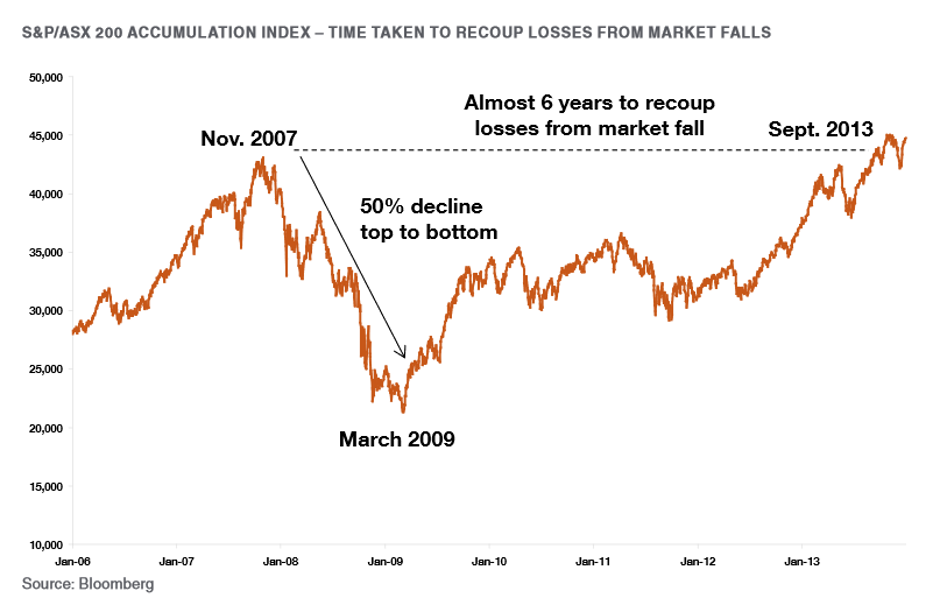1. Investment returns on 'safe' assets are now at historic lows.
Interest rates around the world have never been lower in the last 5,000 years of history, according to an analysis by the Bank of England. The Reserve Bank of Australia has halved rates to 0.75% between May and October 2019.
It may be great news for borrowers, but investors and retirees who save are paying a bigger price than ever.
Real returns, which take the impact of inflation into account, are now negative. In other words, the cost of many everyday items is rising by more than the interest people receive on their savings.

Rates are not going up any time soon – in fact, there may well be more cuts – and given rates are already so close to zero, each cut has an even larger absolute impact on returns.
For example, when the RBA cut rates from 7.25% to 7% as the GFC hit in September 2008, it marked a 3.4% reduction. But when the RBA most recently cut rates from 1% to 0.75%, it marked a 25% reduction.
Before the global financial crisis, term deposits delivered annual income of about 7% and annuities about 7.5%. Today, term deposits are delivering annual income of about 1-1.5% while annuities are down to just 1.5-2%.
These represent huge falls in returns on term deposits and bonds.
2. Investors will need to place their money in 'riskier' assets to generate the same level of returns.
Falling interest rates mean share dividends are more attractive than ever as a source of income.
Many people have no choice but to invest in higher-risk assets such as shares. This is one reason why asset valuations tend to rise in a falling interest rate environment.
But shares have a far higher risk profile than term deposits and annuities. The share market is more volatile and it can take months or even years to regain territory lost in a prolonged downturn.
The benchmark S&P/ASX 200 Index is currently producing a dividend yield of more than 4%. However, dividends are less secure than income from term deposits, annuities, and both government and high-grade corporate bonds.
Many of our biggest companies cut dividends in the wake of the GFC, including ANZ, BHP Billiton, Rio Tinto, Wesfarmers, Woolworths, and CSL. More recently, Telstra cut its full year dividend by almost one-third.
Investors can be hit with a double whammy as Australian companies usually only cut their dividends when earnings are lower than expected. Investors can simultaneously suffer lower income and a reduced share price.
3. Diversification is no longer an effective investment strategy
Portfolio diversification – holding different assets such as shares and bonds – is a popular and proven investment strategy.
It helps to manage overall risk as some types of assets perform differently under different market conditions (although there is still an opportunity cost when equities are performing strongly, as they did in 2019).
However, the GFC showed this is not always the case. Every major asset class fell at the same time, creating major losses for many investors.
The environment today is vastly different. Interest rates are approaching zero (and in some countries are negative), which means traditionally 'safe' assets such as bonds no longer offer the same diversification benefits.
Some super funds are tackling this issue by replacing cash and bonds with investment in infrastructure and other alternative assets.
While they tend to produce healthy income flows with low volatility, there is a problem: no one knows with certainty how these assets will respond in the next market downturn.
This has spurred an industry-wide debate about what type of assets really comprise a balanced fund.
4. The next economic crisis is (statistically) nearer rather than further away.
Markets and economies move in cycles which no one can reliably predict. It's not just time in the market that counts – timing also plays a crucial role when good times are inevitably followed by bad.
It has been more than a decade since the GFC wiped out about half the value of the Australian share market. Since then, the unprecedented rate-cutting action of central banks around the world has propped up many markets and economies for longer than expected.

However, history shows that an economic crisis has struck the world about every six years since World War II, according to the World Competitiveness Centre. This is why many people believe the next downturn is closer rather than further away.
When it does happen, central banks such as the RBA, have far less firepower to stave off the worst effects. With interest rates at historic lows, the limits of monetary policy are being reached.
Meanwhile, governments around the world are now carrying extreme levels of debt as they have attempted to bail out their economies. In Australia, it is households that are carrying heavy debt, thanks to some of the most expensive residential property prices in the world.
The combination of these factors suggest investors would be wise to prepare for the next downturn rather than risking being caught short.
5. The world is in political chaos adding more uncertainty
A key driver behind falling interest rates is rising geo-political risk, which is leading to greater economic uncertainty. The rise of populist governments peddling simple answers to complex problems is now commonplace. Unfortunately, where there are winners there are also losers, as well as other consequences.
Last year, Britain's delayed exit from the European Union and the unknown impact of the US-China trade war dragged down investor sentiment. This year, uncertainty centres around new issues such as the outcome of the US election, the spread of Coronavirus, and how governments will tackle climate change.
So where does this lead us...
These five influences leave investors facing a difficult decision: suffer a catastrophic cut to their income or invest in riskier assets such as shares. As interest rates rapidly approach zero, new investment strategies are called for.
Investors will need to take on more risk to generate the same level of income. Assets such as shares are transparent and easy to understand when compared to alternatives like hedge funds or unlisted assets.
But taking on more risk means there is also a greater need to manage that risk. Australians insure the assets they value such as their lives, homes and vehicles. Investment portfolios are no different.
Major insurance companies have used exchange-traded futures and options for decades to manage the assets on their own balance sheets. Now investors can use the same strategy to manage the risk of a significant market downturn and market volatility.
Low interest rates don’t have to mean low investment returns as long as risk is appropriately managed. Risk management can help protect investors both from the current economic challenges and future uncertainty.
Milliman is a global actuarial firm that provides investment advisory, hedging and consulting services across AUD $215billion in assets. Milliman’s SmartShield Portfolio series provides the ability to turn Milliman’s risk management strategies on or off as markets or client circumstances change. It can be accessed via HUB24 and other platforms.
For more information please go to advice.milliman.com or contact us at [email protected]